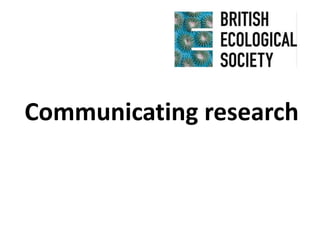
Communicating research a quick guide for undergrads
- 2. Basics of peer review
- 3. How Peer Review Works Author submission Reject Senior editor Associate Editor ReviewersReject Editor makes their decision Reject Accept
- 4. Original submission To SE for assessment To AE for assessment AE Assign reviewers AE makes recommendation To SE for decision Reject Recommend reject Reject with resubmission Revision submittedMajor revision Minor revision To SE for final decision Accept Production Resubmission Revision submitted Howitactuallyworks AssitEd invites reviewers AE asks for re-review AssitEd invites reviewers AE makes recommendation
- 5. How to write a paper (and how you’ll read it) • Title • Abstract • Methods • Results • Discussion • Conclusion
- 6. The title is the hook • Brief and clear • Summarises the main finding of the paper • Must say what your paper is about!
- 7. Abstract tells you to read on… or not • Brief background or justification • Broad description of what you did • Key findings. • Final statement (a synthesis) about the importance of the study.
- 8. The introduction sets the scene • Gives the background for the paper • Tells the reader why they should be interested in the study • Should be a logical train of thought leading the reader to the conclusion that the study is novel, exciting and worth doing.
- 9. Methods • Should give enough information so the reader can • 1) understand how what you did answered the questions you asked • 2) judge whether what you did was the correct approach
- 10. Methods – it’s all about the details • Keep important details eg. number of plots, experimental treatments, frequency of data collection, etc. • Leave out details that have no influence on the measurements, results, or the way the data is collected
- 11. Results • REMEMBER THE WHY - Link results to your research aims or hypotheses to show how the results address the questions you raised Key results Novel findings that you will discuss further Supporting results Lend weight/give evidence for your interpretation of results and to support the conclusions.
- 12. The discussion is the playground • Discuss your results but also: • Remember your introduction Brings together different lines of evidence based on your study and other published work to make sound conclusions and propose new ideas and hypotheses to be tested in future.
- 13. Your conclusion should actually conclude things • What should the reader remember from the paper? • Why should they care? • What should we do next? The worst way to end a paper is to leave the reader thinking: "So what?"
- 14. POSTERS Putting those skills you learnt in primary school to work!
- 15. Why? • Can be seen by hundreds of people. • Excellent way of transmitting scientific information • Easily portable • Easier to read than a paper • Much less risk of stage-fright than a talk!
- 16. Rules of layout (break with caution) • Title - should be at least 2.5cm tall • Text naturally flows right-left and top-bottom • Don’t box off what you want to link • Breathe! Your poster should have about 20% empty space
- 17. Posters are visual representations of your work • Beware the ‘Wall of Text’! • Do your figures and graphics first • Only show what adds to your central message • Stick to a few colours or one colourscheme • Circuses are distracting
- 18. ORAL PRESENTATIONS You’ve got lots to say, but don’t say too much. Opening, Main, Finish and goodbye!
- 19. For science! We got some actors to teach lecturers how to speak better. Some of them did. Some of them went off to do pop-sci TV
- 20. OPENING Get them in the door (hook!) Why you had to do what you did (need) What you actually did/what you found (action) What you’re going to say (preview)
- 21. OPENING Research has shown that academics spend almost 90% of their life attempting to communicate with others, with at least 30% of their life spent talking at people. Despite this, most academics lack any kind of training in public speaking—they learn by observation, but mostly through trial and error. We experimented with using trained performers – specifically, actors- to provide specialised training to see if we could enhance their public speaking. I'm going to give you a little background on some of the particular communication difficulties academics have, go over what kind of training we did and what results we had. Hook Need Action Preview
- 22. MAIN Structure: think tree, not chain 1 key message 3-5 main points 3-5 sub/supporting points
- 23. SUBPOINT MAIN POINT SUBPOINT SUBPOINT SUBPOINT MAIN POINT SUBPOINT SUBPOINT SUBPOINT MAIN POINT SUBPOINT SUBPOINT
- 24. Better at speaking Lecturers lectured better Some lecturers still boring, but clearer Not effective in tutorials Cost- effective Effect lasted >1 year Needs more study for long- term effects The “Brian Cox” effect Some academics left to be media personalities Many cited “better money” Is this a bad thing?
- 25. FINISH YOUR TALK • Review your key message • Tell them when you’re done. “Many thanks for listening. I’m happy to answer any questions you might have”
- 26. Slides are not your notes • Slides are visual aids for the audience (graphs, figures, key points). • Your talk and your slides should stand alone. • A complete sentence is better than a vague title.
- 27. 32% of Academics in the study joined Am-Dram groups within 2 years No further involvement, 58% Joined Amateur Dramatics groups, 32% Signed up with an Extras agency, 8% "Brian Cox" Effect, 2%
- 28. Social Media Public = Professional Professional = Self-Promotion. Your SFW public identity should not link to anything locked.